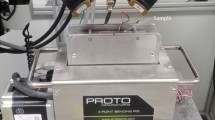Summary
Repeated computer experiments were implemented to investigate material structure weaknesses in polycrystalline materials. The computational investigation relies on behaviors of mesoscopic stress responses in a simulated polycrystalline aggregate containing a fairly large number of constituent grains. A Kröner-Kneer structure-based model was adopted and refined to provide an efficient numerical solution to local mesoscopic stresses, calculated in terms of grain-averaged fields at a material scale of grain size, in arbitrarily polygon-shaped grains. Three criteria have been proposed for classifying material structure weaknesses in the simulated polycrystalline materials. It is found that material structure weakness of three types can be well correlated by a defined “Orientation-Geometry Factor” Ø and “Relevance Parameter”. Every correlated relation, incorporating effects of grain orientation and geometry, provides a base for discerning material structure weaknesses. The homogenization of an anisotropic material is also discussed.
Similar content being viewed by others
References
Sunder, S. S., Wu, M. S.: Crack nucleation due to elastic anisotropy in polycrystalline ice. Cold Regions Sci. Tech.18, 29–47 (1990).
Ghahremani, F., Hutchinson, J. W.: Three-dimensional effects in microcrack nucleation in brittle polycrystals. J. Am. Ceram.73, 1548–1554 (1990).
Lebensohn, R. A., Tomé, C. N.: A self-consistent anisotropic approach for the simulation of plastic deformation and texture development of polycrystals: application to zirconium alloys. Acta Metall. Mater.41, 2611–2624 (1993).
Teng, N. J., Lin, T. H.: Elastic anisotropy effect of crystals on polycrystal fatigue crack initiation. Trans. ASME J. Engng Mater. Tech.117, 470–477 (1995).
Dunn, M. L., Ledbetter, H.: Elastic-plastic behavior of textured short-fiber composites. Acta Metall.45, 3327–3340 (1997).
Lu, Z. K., Weng, G. J.: A self-consistent model for the stress-strain behavior of shape-memory alloy polycrystals. Acta Mater.46, 5423–5433 (1998).
González, C., Llorca, J.: A self-consistent approach to the elasto-plastic behaviour of two phase materials including damage. J. Mech. Phys. Solids48, 675–692 (2000).
Wu, M. S., Guo, J.: Analysis of a sector crack in a three-dimensional Voronoi polycrystal with microstructural stresses. Trans. ASME, J. Appl. Mech.67, 50–58 (2000).
Kocks, U. F., Tomé, C. N., Wenk, H.-R.: Texture and anisotropy: preferred orientations in polycrystals and their effect on materials properties, 1st ed. Cambridge University Press 1998.
Anderson, M. P., Srolovitz, D. J., Grest, G. S., Sahni, P. S.: Computer simulation of grain growth-I. Kinetics. Acta Metall.32, 783–791 (1984).
Humphreys, F. J., Hatherly, M.: Modelling mechanisms and microstructures of recrystallisation. Mater. Sci. Tech.8, 135–143 (1992).
Novikov, V. I.: Grain growth and control of microstructure and texture in polycrystalline materials, 1st ed. Boca Raton: CRC Press 1997.
Anderson, M. P., Grest, G. S., Srolovitz, D. J.: Grain growth in three dimesion: a lattice model. Scripta Metall.19, 225–230 (1985).
Mehnert, K., Klimanek, P.: In: Proceedings of an International Conference on Texture, Sept. 1997, Clausthal, Germany (Schwarzer, R. Bunge, H. J. eds.) Trans. Aedermannsdorf: Tech. Publications 1998.
Roe, R.-J., Krigbaum, W. R.: Description of crystallite orientation in polycrystalline materials having fiber texture. J. Chem. Phys.40, 2608–2615 (1964).
Rose, M. E.: Elementary theory of angular momentum. New York: Wiley 1957.
Mathews, J., Walker, R. L.: Mathematical methods of physics. W. A. Benjamin 1970.
Nye, J. F.: Physical properties of crystals: Their representation by tensors and matrices, 2nd ed. Oxford, UK: Oxford Science Publications 1985.
Eshelby, J. D.: The determination of elastic field of an ellipsoid and related problems. Proc. R. Soc.241A, 376–396 (1957).
Eshelby, J. D.: The elastic field outside an elliptical inclusion. Proc. R. Soc.252A, 561–569 (1959).
Eshelby, J. D.: Elastic inclusions and inhomogeneities. Prog. in Solid. Mech., Vol. 2, (Sneddon, I. N., Hill, R., eds.), pp. 89–140. Amsterdam: North-Holland 1961.
Kröner, E.: Berechnung der elastischen Konstanten des Vielkristalls aus den Konstanten des Einkristalls. Z. Phys.51, 504–518 (1958).
Kröner, E.: Zur plastischen Verformung des Vielkristalls. Acta Metall.9, 155–161 (1961).
Kneer, G.: Uber die Berechnung der Elastizitätsmoduln vielkristalliner Aggregate mit Textur. Phys. Status Solidi9, 825–838 (1965).
Morris, P.: Elastic constants of polycrystals. Int. J. Engng Sci.8, 49–61 (1970).
Bunge, H. J., Kiewel, R., Reinert, Th., Fritsche, L.: Elastic properties of polycrystals-influence of texture and stereology. J. Mech. Phys. Solids48, 29–66 (2000).
Tvergaard, V., Hutchinson, J. W.: Microcracking in ceramics induced by thermal expansion or elastic anisotropy. J. Am. Ceram. Soc.71, 157–166 (1988).
Oritz, M., Suresh, S.: Statistical properties of residual stresses and intergranular fracture in ceramic materials. Trans. ASME, J. Appl. Mech.60, 77–84 (1993).
Nozaki, H., Taya, M.: Elastic fields in a polygon-shaped inclusion with uniform eigenstrains. Trans. ASME, J. Appl. Mech.64, 495–502 (1997).
Waldvogel, J.: The Newtonian potential of homogeneous polyhedra. ZAMP30, 388–398 (1979).
Rodin, G. J.: Eshelby's inclusion problem for polygons and polyhedra. J. Mech. Phys. Solids44, 1977–1995 (1996).
Jasiuk, I., Chen, J., Thorpe, M. F.: Elastic moduli of two-dimensional materials with polygonal and elliptic holes. Appl. Mech. Rev.47, 18–28 (1994).
Jasiuk, I.: Various vis-a-vis rigid inclusions: elastic moduli of materials with polygonal inclusions. Int. J. Solids Struct.32, 407–422 (1995).
Wu, L. Z., Du, S. Y.: The elastic field with hemispherical inclusion. Proc. R. Soc. Lond.455A, 879–891 (1999).
Mura, T.: A theory of fracture with a polygonal shape crack. In: Small fatigue cracks: mechanics and mechanisms (Ravichandran, K. S., Ritchie, R. O., Murakami, Y., eds.), pp. 3–15. London: Elsevier 1999.
Ru, C. Q.: Analytic solution for Eshelby's problem of an inclusion of arbitrary shape in a plane or half-plane. Trans. ASME, J. Appl. Mech.66, 315–322 (1999).
Simmons, G., Wang, H.: Single crystal elastic constants and calculated aggregate properties: A handbook, 2nd edn. Cambridge: MIT Press 1970.
Zeng, X.-H., Ericsson, T.: Anisotropy of elastic properties in various aluminium-lithium sheet alloys. Acta Mater.44, 1801–1812 (1996).
Yang, S. W.: Elastic constants of a monocrystalline nickel-based superalloy. Metall. Trans.16A, 661–665 (1985).
Bunge, H. J.: Texture analysis in materials science, 1st ed. London: Butterworths 1982.
Author information
Authors and Affiliations
Rights and permissions
About this article
Cite this article
Li, X.D. Numerical correlation of material structure weaknesses in anisotropic polycrystalline materials. Acta Mechanica 155, 137–155 (2002). https://doi.org/10.1007/BF01176239
Received:
Revised:
Issue Date:
DOI: https://doi.org/10.1007/BF01176239




